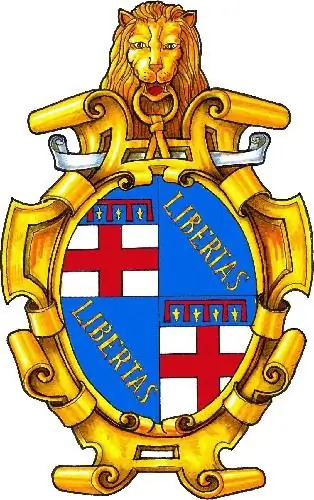
This ancient Italian city, located in the northern part of Italy, has many advantages and attractions. It is called the culinary capital of Italy, the oldest university capital. At the same time, the coat of arms of Bologna does not contain any elements related to cooking or education. The details placed on the city's heraldic sign are associated with political symbols, demonstrating the residents' desire for freedom and an independent path of development.
Description of the coat of arms of Bologna
A color photo will highlight the colorful heraldic mark of this Italian city. To depict the central and secondary elements, the authors of the sketch chose the most presentable colors that are considered the main ones in heraldry - gold, silver, azure, scarlet.
A characteristic feature of the coat of arms of Bologna is the unusual shape of the shield. It has a lot of decorative ornaments and curls, more like the frame of an old mirror than part of a knight's military equipment.
There is one more highlight - the head of a lion, which completes the heraldic composition. The animal's ears are unusually drawn, they are shown pointed at the ends. The second feature is that the lion holds a ring in its teeth, to which the shield is attached. In general, the composition of the coat of arms of Bologna has the following elements:
- a golden shield with images and colors repeating in the inner field;
- a silver ribbon resembling a scroll;
- head of a predatory animal with a ring in his hands.
The inner field of the shield is divided into four parts with repeating patterns. In two fields you can see the image of another official symbol of Bologna - the flag, that is, a silver cloth with a scarlet cross. Moreover, one flag is placed horizontally, the second is shown in a vertical position. In the same fields, there are smaller details of scarlet and gold color, also placed in two directions.
The other two fields are azure with a gold inscription in Latin LIBERTAS, which means "freedom". The desire for independence of local residents is evidenced by the fact that in 1256 in Bologna the authorities adopted the so-called "law of paradise", according to which serfdom in these territories was abolished.
At the same time, the city has more than once become the prey of the armies of various European states, for example, the French and Austrians left traces of their stay here. Therefore, the appearance on the coat of arms of Bologna, state symbols, the flags of the city and the inscriptions "Freedom" can be considered quite justified.






